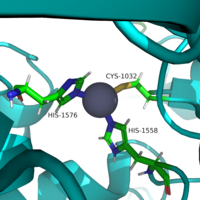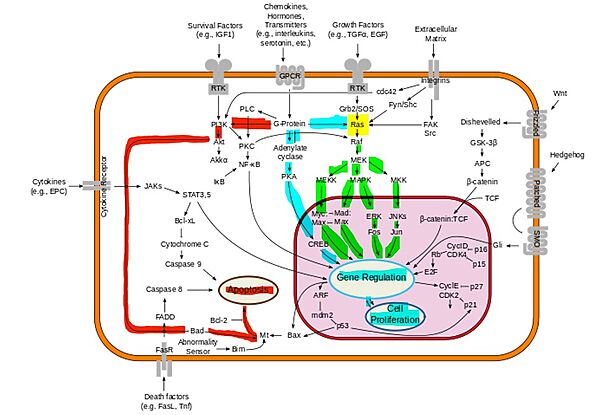Introduction
(NF) is a cytoplasmic protein encoded by the NF1 gene located on chromosome 17 [1]. It is localized to the cell membrane by the SPRED 1 protein[2]. The neurofibromin protein in encoded by over 350 kb of DNA and contains 62 exons, 58 of which are constitutive[3]. NF suppresses the oncogene by increasing the rate of hydrolysis from (active) to (inactive)[4]. Increasing the rate of Ras inactivation decreases cell proliferation linked to cancer[5].
Structure
Neurofibromin is a large protein of 2818 amino acids [1] and is a homodimer that exists in two conformations.
Domains
consists of multiple domains. (Figure 1). A few notable ones are the N-HEAT/ARM, GRD, Sec14-PH, and C-HEAT/ARM. The two most characterized domains of neurofibromin are the Sec14-PH and GRD domains. Each of the protomers of neurofibromin contains these domains.

Figure 1. Representation of the Domains of Neurofibromin. Shown are the most characterized domains, Gap-related and Sec14-PH, connected to the N and C-HEAT/ARMs. Each of the domains of Neurofibromin can be found in both of the monomers.
N-HEAT/ARM and C-HEAT/ARM
Heat domains are domains found in cytoplasmic proteins that consist of four different proteins: Huntingtin, elongation factor 3, protein phosphatase 2A, and TOR1. [6]. The HEAT / ARM cores are made up of many alpha helices. The N-HEAT/ARM and C-HEAT/ARM are rigid, which makes them critical in the rearrangement of the Gap-related and Sec14-PH domains. In the , the HEAT/ARM domains cover the GRD, preventing the binding of Ras through steric hinderance. [7]
GRD domain
The Gap-related domain, or , is the catalytic domain of neurofibromin. It ranges from residues 1196 to 1547. [2] Its main catalytic mechanism is the hydrolysis of GTP-bound Ras into GDP-bound Ras, which converts Ras from its active form into its inactive form. The GRD provides an arginine residue, known as the arginine finger, to Ras. The location of the Gap-related domain is shifted between the and closed conformations of neurofibromin.
Sec-PH
The domain is the lipid-binding domain of neurofibromin, found in residues 1565 to 1835. [2] In the closed conformation of neurofibromin, the hydrophobic core is blocked by the Gap-related domain. The allows the hydrophobic core in the Sec cavity to be accessible and exposed. In neurofibromin, this cavity binds glycerophospholipids, which can induce conformational changes. [8] It is unclear if the Sec14-PH domain has a role in the RasGap activity of neurofibromin.
Important Structural Features
Conformations
The two conformations that neurofibromin exists in are the open state and closed state. The conformational change of neurofibromin involves rearrangement of the domains.
Closed Conformation
The of neurofibromin has both protomers in a closed conformation, which inhibits the binding of Ras to the GRD of neurofibromin due to the HEAT/ARM core blocking the GRD. A metal binding site between the N-HEAT/ARM domain and the GRD-Sec14-PH linker stabilize the closed conformation. This site is coordinated by three residues, . (Figure 2). This binding site is preferential for zinc- zinc has been found to stabilize the closed conformation of neurofibromin. In the absence of zinc, neurofibromin is in the open conformation. [2]

Figure 2. Triad of Residues that keep Neurofibromin in the Closed Conformation. The residues shown are C1032, H1558, and H1576. In the center of those residues is a zinc ion, shown in grey.
Open Conformation
The of neurofibromin has one protomer in a open conformation and the other in a closed conformation. The protomer in the open conformation allows for the binding of Ras because of reorientation of the GRD and Sec14-PH domains. In the open conformation, the metal binding site found in the closed conformation is lost due to separation of the N-HEAT/ARM and the cysteine residue from the histidine residues founds in the GRD-Sec14-PH linker. The loss of the metal binding site in one of the monomers allows for Ras to bind to the Gap-related domain due to the loss of steric hinderance.
Transition Between Open and Closed Conformation
In the transition from the closed state to the open state, several of the domains of neurofibromin rotate to make the binding site of neurofibromin more accessible . This rotation is able to occur due to the rotation of three connective linkers, L1, L2, and L3. is located between an alpha helix 48 in N-HEAT and an alpha helix 49 in GRD. G1190 is a potential hinge point when L1 rotates and pushes the alpha helices outwards to move the Gap-related domain. is located between the Sec14-PH domain and the C-HEAT/ARM and aids in the movement of the Sec14-PH domain. The proximity of L1 and L3 has to be close to facilitate the rotation of the domains. starts at the last helix in the Gap-related domain and extends to the Sec14-PH domain. Its primary role is to move the Sec14-PH domain away from the GRD. Without these rotations, the membrane binding sites are occluded and inaccessible. [2]
SPRED-1 Protein
The SPRED-1 protein to the cell membrane in to allow it to bind to the membrane oriented Ras protein[2]. interacts with the N-terminal domain of NF to guide it to the membrane from the cytosol, where its C terminal domain will determine its target [9]. GAPex, a subdomain located in the GRD, has been found to help SPRED-1 bind to neurofibromin. [7]
Ras binding site
associate through the arginine finger, 1276 that comes from neurofibromin. This arginine is referred to as the “arginine finger” and assists in the hydrolysis of GTP by binding to a backbone carbon atom of tyrosine 32 of Ras when neurofibromin is in the open conformation. It points into the of Ras when neurofibromin is in the open conformation. R1276 also helps stabilize the position of Glutamine 61, a key catalytic residue, through hydrogen bonds, as well as GTP.
Glutamine 61 of Ras is a residue that facilitates the conversion of GTP to GDP, turning Ras from its active state to inactive state. There is a catalytic water molecule that glutamine interacts with to position the molecule for a nucleophilic attack on the gamma phosphate of GTP. Mutations of this residue have been related to lower rates of hydrolysis. [10]. Tyrosine 32 makes water-mediated hydrogen bonds with the gamma phosphate of GTP. This position is also where Ras is phosphorylation to promote the activity of GTPase-activating proteins and GTP hydrolysis. [11]
Disease Relevance
Mutations to the neurofibromin protein are implicated in the progression of Neurofibromatosis type 1. Neurofibromatosis type 1 is a condition where cancer develops by inactivating the Ras suppression effects of NF, allowing Ras to behave as an oncogene. Neurofibromatosis type 1 is an autosomal dominant disorder that affects 1 in 3,000 people. The NF gene has the highest mutation rate of any human gene, adding to the prevalence of cancers related to neurofibromin mutations[7]. Furthermore, these mutations consist heavily of de novo mutations[12]. NF1 primarily causes tumors in the central and peripheral nervous systems, but often has a multisystem expression including tumors in the dermatologic, cardiovascular, gastrointestinal, and orthopedic systems [5]. The wide range of presentations is consistent with the multiplicity of mutations observed in the causative protein[13]. This multiplicity derives from the immense size and homo dimeric nature of the neurofibromin protein that allows for otherwise innocuous mutations to wreak havoc on the conformations of the protein as well as its ability to bind to the Ras protein given that the positioning of NF relative to Ras is highly important.
Downstream Effects
Misregulated Ras activity can lead to uncontrolled signaling in many different cell signaling pathways. Figure 2 provides an overview of the pathways that are connected to Ras. As shown, neurofibromin's ability to regulate Ras activity can alter cell proliferation signaling, activation/ inactivation of transcription factors, and cell apoptotic factors, making its proper functioning crucial [14]. Additionally, due to its overall importance in multiple cell pathways, neither neurofibromin nor Ras profile as possible drug targets.

Figure 3: Downstream proliferation of Ras signals have a variety of impacts, including gene regulation, cell proliferation, and cell growth; By cybertory - This file was derived from: Signal transduction v1.png, CC BY-SA 3.0,
https://commons.wikimedia.org/w/index.php?curid=12081090 Neurofibromin 3D structures
Neurofibromin; Domains – gap-related domain (GRD) 846-1530; Sec14 homology domain (Sec-PH) 1566-1837
Updated on 13-July-2023
1nf1 – hNF GRD – human
7moc, 7mp5, 7mp6, 7pgp, 7pgq, 7pgr, 7pgs, 7pgt, 7pgu, 7r03, 8e20 – hNF – Cryo EM
7r04 – hNF + GDP derivative – Cryo EM
2d4q – hNF Sec-PH
3peg – hNF Sec-PH (mutant)
2e2x – hNF Sec-PH + phosphoethanolamine
3p7z, 3pg7 – hNF Sec-PH (mutant) + phosphoethanolamine
6ob2, 6ob3 – hNF GRD + GTPase KRas + GNP
6v65, 6v6f – hNF GRD + GTPase KRas + SPRED1 + GNP



